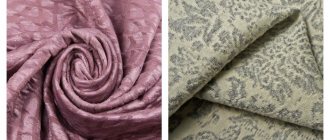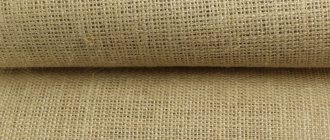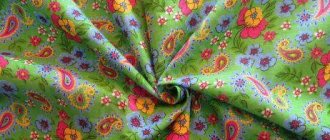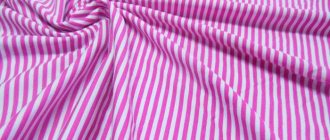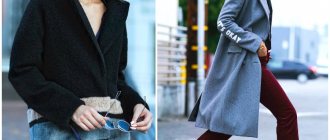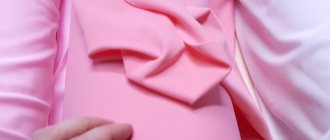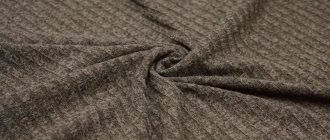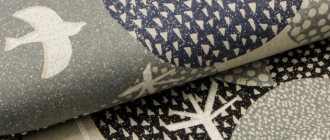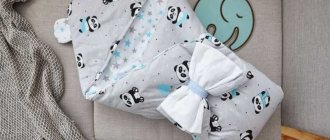Criteria for quality upholstery
To choose high-quality fabric for a sofa, you need to consider the following factors:
| Criterion | Best performance |
| Wear resistance | From 30000-40000 rpm |
| Density | From 350-450 g/cm² |
| Pilling (rolling on a 5-point scale) | 4-5 points |
| Material tensile strength | Up to 45-50% |
| Seam tensile strength | No more than 3-4 |
| Color fastness to friction on a 5-point scale | 4-5 points |
| Fire resistance (5 classes) | 1-2 grade |
In addition to these criteria, the composition of the material is important. Sofa upholstery fabric can include only natural or synthetic components, or a combination of both. With a mixed composition, the percentage of each type of fiber is important.
Important! The environmental safety of textiles is confirmed by the European Oeko Tex Standard certificate. It is issued for a year and is renewed only upon successful completion of re-testing.
Breathability is also important. It is affected by the density, thickness of the fabric, and weaving of the threads. If the upholstery does not allow air to pass through, it will escape through the seams, which can cause them to rupture. There are other consequences - unpleasant odor, fungus, mold.
How not to make a mistake with your choice: everything about the categories of furniture fabrics.
Upholstered furniture is a fairly simple and ordinary piece of furniture. However, in fact, this upholstered furniture performs many functions necessary for a comfortable rest. That’s why a lot of attention is paid to the reupholstery and upholstery of a sofa for the home or office. One of the important selection criteria is the upholstery of the sofa. Firstly, it must be combined with the interior of the room and not discord with existing furniture. Secondly, the quality of the upholstery must correspond to the operating conditions of the furniture. That is, if you plan to reupholster a sofa in a bedroom, then upholstery made of fabric with natural fibers would be preferable. Office sofas most often have synthetic or natural leather upholstery, since it is considered more wear-resistant, easier to clean and gives the furniture a presentable look.
When choosing upholstery for a sofa, you should pay attention to the following parameters of the upholstery material:
• appearance; • strength characteristics; • operational properties.
The generally accepted classification of furniture materials is a fairly conventional gradation of fabrics according to a number of characteristics. It is worth noting that the category to which the fabric belongs speaks no longer about quality, but rather about its operational parameters: density, type, lightness and pricing policy of the manufacturer. As a rule, as the category increases, the density and cost of the fabric increases (and therefore the price for reupholstery and upholstery of upholstered furniture made in this upholstery option). The higher the density of the fabric, the longer the service life of the upholstery. Popular fabrics such as chenille or flock are in fabric categories 1-6. Materials with high density and complex texture are classified in a higher category. In total, there are 8 main categories:
0 category
- light, fragile, but cheap fabrics: cotton, scotchgard, thermal jacquard, lightweight chenille;
Category 1
- slightly denser than the fabrics of the previous category: flock, chenille, corduroy, suede, thin tapestry;
Category 2
- combined chenille-jacquard, as well as fabrics that are included in the first category, but with a higher density;
Category 3
- “medium-heavy” fabrics with a complex texture: dense chenille, tapestry, suede, boucle chenille;
Category 4
- very dense heavy fabrics: chenille, tapestries, suede with a pattern;
Category 5
- dense furniture fabrics with natural fibers;
Category 6
- artificial leather, including the universal material Arpatek, which is used for upholstery of car seats;
Category 7
- cheap genuine leather;
Category 8
- expensive genuine leather of excellent quality, characterized by greater thickness and high elasticity.
Types of fabrics used for upholstery of upholstered furniture
Cotton
is a natural material, non-toxic and environmentally friendly, for this reason it is perfect for a children's room.
Cotton fabrics dye well, absorb sweat and allow air to pass through to the skin. The only disadvantage of cotton is its limited service life, which is no more than 5-7 years of active use. To make the fabric more durable, manufacturers coat it with a layer of a special compound that protects it from color loss and abrasion, and also prevents it from collecting dust. Cotton fabric is often used to upholster sofas intended for children's room interiors. As a rule, children's upholstered furniture is required until the child grows up, and the service life of the upholstery is just enough for this time. Well, after a little restoration, the furniture will be able to serve even younger sisters or brothers. Due to the fact that cotton fabrics are the most inexpensive, the interior of a children's room can be updated at low financial cost. Jacquard
is a fairly dense, light, elegant and high-quality fabric with a certain weaving method. The wear resistance and thickness of the jacquard is determined by the type of threads that were used to create it. In fabrics belonging to the zero category, these threads are very thin. Jacquard is durable, less susceptible to abrasion, does not fade, maintaining its rich color for many years. The design is complex, refined, often with woven gold and silver threads.
To make high-quality orthopedic mattresses, a type of jacquard is used - stretch jacquard.
This fabric has a “breathable” effect, perfectly absorbs moisture and increases the service life of the mattress, and thanks to the use of special impregnation, it is possible to avoid the appearance of static electricity. Thermal jacquard and scotchgard
are types of jacquard.
Thermal jacquard is a jacquard dyed through transfer printing. Scotchgard is a jacquard fabric with a special dirt-, dust-, oil- and water-repellent impregnation (synthetic protector), which gives the material increased strength and resistance to stains. This transparent layer preserves the threads, allowing them to withstand various mechanical loads. Scotchgard is most suitable for sofas intended for intensive use. Well, the beauty of the fabric allows you to use such exquisite furniture in the interior of the most fashionable living room. Lovers of antiquity will appreciate the noble classics of jacquard, and fans of modernism will definitely appreciate its unusual texture. Tapestry
is the same jacquard in its essence, but is made from a larger number of threads. If there are up to 10 of them in a jacquard, then in a tapestry - up to 100. Both sides of tapestry fabrics are suitable for upholstery, since the material is a double-sided fabric. Tapestry is the oldest of all types of fabrics, known since the 14th century. Light industry presents a huge range of tapestry fabrics for furniture. Tapestry upholstery is traditionally durable and strong, with interesting designs ranging from classic subjects to funny children's pictures and colorful avant-garde.
In the production of tapestry fabrics, cotton, wool and various synthetic fibers are used, the addition of which increases the wear resistance of the fabric.
The tapestry is also treated with a special impregnation that increases its resistance to stains. Flock
is a durable, reliable, beautiful, fireproof and environmentally friendly upholstery fabric.
Inexpensive flock looks like traditional velvet. Usually consists of a base (35% cotton and 65% synthetics), on which nylon or nylon pile is applied, which gives the material a velvety surface. Please note that all synthetic fabrics accumulate static electricity, so a flock sofa will crackle slightly when you sit on it. Noble flock upholstery is an excellent decoration for a living room sofa. It withstands any food contamination, wet dog paws, and even the sharp claws of a cat are practically unable to pull threads out of it and leave no marks on its surface. If you have pets and small children in the house, we recommend choosing a sofa upholstered in flock. Since hypoallergenic dyes are used to color flock, and it itself is treated with a hypoallergenic composition, it can be used even if you are prone to allergic diseases or have small children. Modern types of flock have a special silicone coating, which gives the fabric a special softness and makes it soft and pleasant to the touch. The only disadvantage of flock is that under constant and heavy loads, the pile of the material wrinkles, and as a result, the sofa significantly loses its appearance. Therefore, you should not choose it for upholstery of a sofa that is constantly used as a bed. Chenille (from the French “chenille” - caterpillar)
is a common upholstery fabric with thick and soft pile, which harmoniously combines natural and synthetic fibers.
Spectacular and beautiful chenille covering of upholstered furniture is most suitable for a living room sofa or a children's sofa. It is pleasant to the touch, has a wide range of shades, creates a feeling of comfort and warmth in the home, and can provide the sofa with an aesthetic appearance over a long service life, while maintaining its unique characteristics for decades. Chenille upholstery is easy to use, has high wear resistance and durability. The fabric is soft to the touch and can withstand up to 70 million touches, which equals 50 years of flawless service. Chenille is not afraid of dust (it can be easily removed with a vacuum cleaner, soft brush or sponge), moisture and sharp claws of pets. Velvet or velvet
- needs no introduction, has a characteristic “ribbed” texture, smooth on the inside.
The corduroy upholstery has a pleasant tint of color. The density of the fabric depends on the manufacturing method. When weaving a fleecy thread with one warp thread, a loose material is obtained. To obtain a fabric with a higher density, it is necessary to use two warp threads. A very pleasant to the touch and durable material, it is usually produced in a plain color or with a printed pattern in the form of stripes, checks, etc. If stains form on the fabric, they can be carefully removed by blotting movements, using stain removers. Furniture suede (microfiber)
is a soft, flexible and pleasant to the touch fabric with low pile, made using ultra-modern technologies, a realistic imitation of its natural counterpart.
To improve the performance properties of the material, it is coated with Teflon, as a result of which the suede acquires dust- and moisture-repellent properties and stains do not form on its surface. The pleasant pile of artificial suede lies in the direction of movement of the palm, externally the material is indistinguishable from natural suede. Due to their impeccable appearance, sofas with microfiber upholstery are often used in living room furnishings. At the same time, suede is practical: like chinillas, it does not lose its quality for a long time, allows air to pass through freely, does not stretch under load, does not roll down, is environmentally friendly and safe for health. Genuine leather
is a valuable and expensive material of varying quality.
A sofa upholstered in genuine leather is not only a luxurious piece of furniture, it is an indicator of the high status and success of the owner of a home or office. Genuine leather is made from the skin of cattle, sheep (velor, morocco, chrome) and pigs and horses (chrome, yuft). The leather upholstery is unique, it “breathes” and adapts to temperature changes, making it very comfortable to use. Like fabrics, genuine leather is divided into categories that have letter and number designations. The category of leather is determined depending on the thickness (from 1 to 5 mm), quality of workmanship, elasticity and strength of the material. Thanks to modern aniline dyes, leather is given a variety of colors close to natural, or fancy and unusual shades. For an executive sofa in the office, it is better to choose luxurious and noble aniline leather. If the furniture is intended, for example, for a home where children and pets live, then you should opt for semi-aniline - the leather of this type is more protected. To improve the appearance, the leather is polished using special compounds. Today, manufacturers use two types of polishing - lead-based and chromium-based. The first treatment, although cheaper, is unsafe for health. Artificial leather (vinyl leather, leatherette)
is an environmentally friendly, healthy material,
manufactured using modern technologies based on various polymers. Artificial leather is produced by applying a PVC coating to fabric, knitwear, reinforced materials and paper. Visually, the material differs little from genuine leather, but at the same time it has higher strength and, as a result, durability. Leatherette upholstery is quite elastic, soft to the touch, resistant to abrasion and deformation, and has a variety of colors and textures. And at the same time, it is 50-70% cheaper than genuine leather.
Leatherette is sensitive to high temperatures and direct sunlight, so it is not recommended to place this sofa close to heating radiators and windows.
Arpatek
- the material was originally developed as upholstery fabric for car seats, and therefore meets the high requirements of comfort and operation. Subsequently, this durable fabric began to be used in the production of furniture, shoes, etc. Arpatek has no analogues, and to the touch it is very reminiscent of thin, soft leather of excellent quality. The upholstery is tear-resistant, resistant to mechanical stress and ultraviolet radiation, excellently retains color and retains its impressive appearance for many years, and also does not stick to the body in the heat and does not harden in the cold. The material contains up to 42% viscose, 25% cotton and 33% polyurethane.
Caring for this material is very easy and simple.
Arpatek is easy to clean, is not afraid of water, natural juices, wine and does not fade in the sun. Eco-leather is a modern synthetic material with a surface texture that imitates leather as realistically as possible. Despite its synthetic nature, eco-leather is an environmentally friendly and breathable material with excellent air permeability. When you touch eco-leather upholstery, you feel softness, elasticity and warmth, just as if you touched genuine leather upholstery. At the same time, the material is durable, resistant to abrasion and low temperatures. The basis of eco-leather is 100% cotton fabric, soft and hygienic, but at the same time strong enough to stretch and tear. A special polyurethane coating is applied on top of the base, which has pores, thanks to which the material gains the ability to “breathe”. And the Teflon layer allows the material to serve for many years without wear and loss of aesthetic properties. The unlimited color range includes several dozen basic shades, which allows you to create original furniture designs. Eco-leather allows you to combine practicality, comfort and a reasonable price in the finished product.
Categories of fabrics for upholstery of sofas
In terms of density and strength, sofa upholstery falls into one of the following categories:
- 0 (cotton, scotchgard) - the most budget option, usually natural fibers, strength and service life are low;
- 1 (corduroy, flock with a fabric base) – strength and durability are slightly higher;
- 2 – higher strength, ease of maintenance, average price;
- 3 (tapestry, chenille) – complex texture, more varied design, requires special care;
- 4 (chenille, suede) – high density, tensile strength, price and quality are optimally combined;
- 5 – high density, wear resistance, natural base, varied designs, but requires constant care, high price;
- 6 (artificial leather, arpatek) – properties are similar to the previous category;
- 7 – low-density genuine leather in the budget segment;
- 8 – expensive genuine leather, good elasticity, high quality.
The category and other information about the upholstery or finished sofa is contained in the product passport.
Kinds
Various materials can be used to cover upholstered furniture. They have their own parameters and properties. It is advisable to study all types in advance, as well as view photos of furniture with each type in order to make the right choice.
Velours
Velor is considered a rather interesting choice for creating high-quality furniture upholstery. Its main features include:
- velor is velvety to the touch, so it is incredibly pleasant to touch;
- the pile on such a coating can always be located in a vertical state, or in certain areas of the coating it can be laid on one side;
- velor can be made using different bases, for which cotton or wool is used, with a wool base being used most often;
- It is easy to care for the velor coating, as it is created using high-tech fibers;
- this upholstery fabric for furniture has antistatic parameters;
- is a hypoallergenic material;
- contaminants are easily removed from the surface.
However, velor has some disadvantages. This includes the high cost of the material. Additionally, velor does not have good resistance to various mechanical influences.
Scotchgard
This modern material has the same positive parameters as jacquard, but at the same time has a low price. Its advantages include:
- long service life;
- resistance to various stains;
- environmental cleanliness due to the use of only natural ingredients;
- the softness of the resulting upholstery;
- high coating strength.
Various stains can be easily removed from this material for upholstery of upholstered furniture, for which a standard soap solution is suitable. It is not allowed to use abrasives, wash the fabric at high temperatures or let it dry.
Jacquard
Jacquard is used quite often for furniture upholstery. This material has an original ornament, and there is certainly a large report. When choosing jacquard fabrics, it is determined whether their composition will be plain or mixed.
Jacquard is an expensive material, so when choosing it, you should prepare for significant expenses.
The advantages of this material include high strength and long service life. It is available in numerous colors, but has a high cost. If you choose a material with an anti-claw effect, it will be expensive.
Thermo-Jacquard
This material appeared relatively recently. Choose the optimal fabric for each soft interior item. Coloring is done using thermal printing technology. A special feature of this material is the presence of unusual and unique colors, and the bright colors last a long time. Additionally, the fabric is highly wear-resistant and durable.
Chenille
Chenille is chosen quite often for various upholstered furniture. The material got its name due to the fact that the composition includes a special thread, similar to a caterpillar with a high pile.
The positive parameters of using this material include:
- it is possible to choose fabric with an anti-claw effect, which is important for every pet owner;
- the material has good density;
- considered a durable fabric;
- dust can be easily removed with a conventional vacuum cleaner with appropriate attachments;
- the price is acceptable for every buyer.
Chenille is produced on an adhesive or fabric basis. The disadvantages of the material include its low cost before exposure to moisture, as well as the drying time after cleaning.
Flock
Flock is a popular finishing material. It is made using cotton and polyester. A pile is applied to the surface of the base using the electrostatic method. Flocking is considered a popular procedure that allows you to obtain high-quality material, which is chosen quite often among decorative products.
Flock has the following advantages:
- good strength;
- ease of care;
- resistance to exposure to sunlight, moisture or dirt;
- has an attractive appearance.
Flock is an environmentally friendly material. It is highly dense and holds its shape well. Therefore, when answering the question of which fabric is best for upholstery, the choice often falls on flock.
Microfiber
The material does not fade, does not fade with constant exposure to ultraviolet radiation and has good resistance to moisture. May have a special anti-claw effect. Before choosing microfiber for upholstery, please note that the material should not be exposed to high humidity or temperature.
The main disadvantage is the high cost. For a long service life of such upholstery, you will need to put a lot of effort into specific care. To do this you will have to purchase special care products.
Faux leather
The most popular types of upholstered furniture are made of natural or artificial leather. If you purchase such upholstery for rooms where pets live, then there must certainly be anti-claw protection. It is so called because it provides effective protection of the material from animal claws.
High-quality artificial leather has parameters similar to natural material, but has an acceptable cost. Provides truly attractive, luxurious and unusual upholstery.
Genuine Leather
The use of such material will require significant financial investments. Its advantages include high attractiveness, ease of maintenance, and it fits perfectly into different interior styles.
The cost of the material is considered high, and if animals live in the house, then anti-claw protection must be used, otherwise the upholstery will quickly lose its attractiveness due to the impact of pets’ claws.
Velveteen
The advantages of this material include:
- high resistance to wear;
- environmental cleanliness;
- good elasticity;
- high strength;
- ease of care;
- acceptable cost.
The disadvantages include fading in the sun and shrinkage after washing. Various mechanical influences contribute to the loss of attractiveness of the fabric.
Arpatek and faux suede
Previously used to form armchair upholstery. It is a type of artificial leather. Its advantages include resistance to ultraviolet radiation and abrasion. It is tear resistant. Its cost is considered quite high, but it is due to its positive parameters.
The use of artificial suede for furniture upholstery is considered quite popular. The material is pleasant and has an unusual texture. Each piece of furniture with such upholstery, which uses artificial suede for furniture upholstery, looks elegant, unique and luxurious.
Tapestry
It is presented in a soft material with an organic weave of yarn, which creates an unusual pattern. The tapestry is available in numerous colors and textures.
Anti-vandal fabric is easy to wash, durable, pleasant and practical. Tapestry is a plastic material, so it can be used for various interior items. Its advantages include, first of all, its naturalness. The tapestry has an attractive appearance.
The disadvantages include not very good resistance to different loads. It is not allowed to clean the tapestry using wet methods, and it also has a high cost.
Velvet
Velvet is a unique fabric with fluffy pile, but it should be short. If the pile is long, then the material is called velor. Velvet is usually chosen for interior items with specific shapes.
Velvet fabric can have different patterns and is also available in a single color.
Velvet makes any sofa or armchair elegant, luxurious and fits perfectly into different classic interior styles. The most commonly chosen materials are black or blue velvet. These colors help create a unique atmosphere in any room.
Names and properties of materials
Sofa upholstery can be textile or non-woven. Before choosing, you should study the characteristics of each type.
Leather
This material attracts with its prestigious appearance, durability, and strength. The leather is easy to clean, it does not collect dust and hair, and is moisture resistant.
Among the disadvantages are the price, limited color range, and the risk of scratching or burning the surface. Sofas with such upholstery are slippery, so they are not suitable as a sleeping place. The material can be unpleasant to the touch - it is cold and sticks to bare skin.
Leatherette
This option is a good replacement for genuine leather. Its artificial counterpart is quite durable, not afraid of dirt and moisture, and is cheaper. Leatherette practically does not absorb odors and is easy to clean. It does not cool, unlike natural material, but also sticks to the skin.
Faux upholstery will crack over time. It is poorly affected by high temperatures and direct sunlight. Another disadvantage is the limited color range.
One of the options for artificial upholstery is eco-leather. It is a polyurethane with a porous structure and a dense cotton base. This material is wear-resistant and breathable. With an external resemblance to genuine leather, the price is several times cheaper.
Faux suede
This woven material is also called furniture suede. It is microfiber. It has low pile and a lot of micropores in its structure. Externally, artificial suede is almost no different from natural one, attracting with its pleasant velvety surface. This material is durable, abrasion-resistant, and affordable. An important plus is the large selection of colors.
Author:
Anastasia Kukushkina
I hope you enjoy the article I have prepared for you! If you find errors in it, write to me about it! I will answer any questions you have, ask them!

